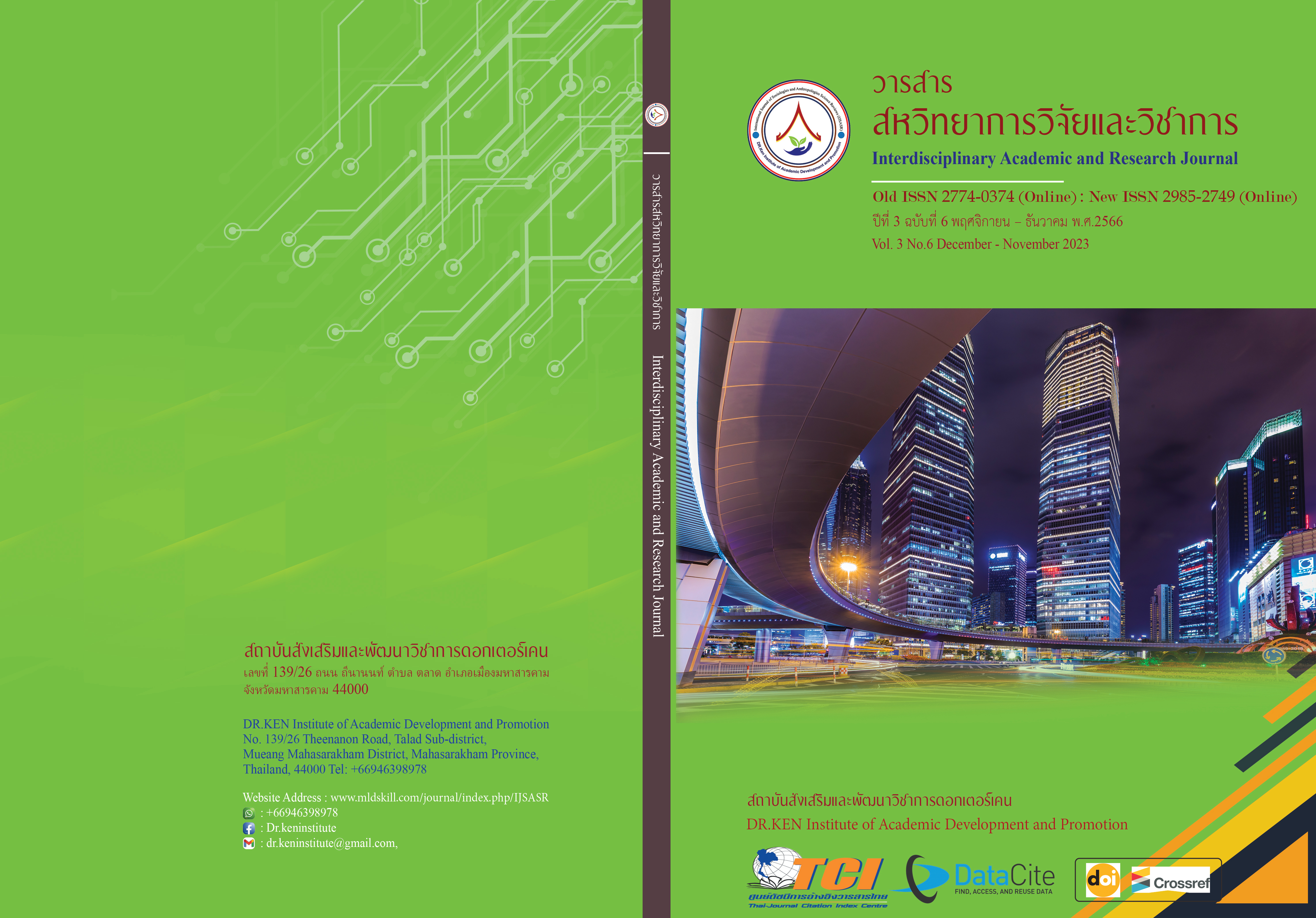Development of Online e-books Using Active Learning to Promote the Thai Reading Skills of Students in Prathomsuksa 6
DOI:
https://doi.org/10.60027/iarj.2023.272624Keywords:
E-books; , Active learning; , Reading Skills; , Thai languageAbstract
Background and Aims: Reading is an essential skill for students in Prathomsuksa 6. The objectives of this research are: 1) to study the effectiveness of online e-books using active learning to promote the Thai language reading skills of students in Prathomsuksa 6 of Natthabanjongwittaya School in Lampang Province to have efficiency according to the criteria of 80/80, 2) To compare students' reading skills before and after school in Prathomsuksa 6 of Natthabanjongwittaya School in Lampang Province, studying through online electronic books By using active learning; 3) To compare the academic achievement before and after learning of students in Prathomsuksa 6 at Natthabanjongwittaya School in Lampang Province who study through online e-books using active learning and 4) To investigate the satisfaction level of Prathomsuksa 6 students at Natthabanjongwittaya School in Lampang Province, explore online e-books using active learning.
Methodology: This research's population and target group are 30 students of Prathomsuksa 6 of Natthabanjongwittaya School in Lampang Province. The research tools used in this study include a proactive learning plan, online e-books, reading skills assessments, the student achievement assessment form, and the student satisfaction assessment form. The 80/80 criteria from the E1/E2 formula were used to analyze the effectiveness of online e-books. A T-test analysis was used to compare reading skills and academic achievement before and after the study. The mean and standard deviation were used to analyze the satisfaction level of Prathomsuksa 6 students at Natthabanjongwittaya School in Lampang Province who study online e-books using active learning.
Results: The research results found that 1) the developed online e-book had an efficiency of 85.33/89.22, following the specified criteria; 2) the average score of students after studying with online e-books using active learning had a percentage of progress higher than the score of the student's pre-study reading skills assessment by 25.95 percent; 3) the average score of students after studying with online e-books using active learning had a percentage of progress higher than the students' academic achievement scores before studying by 54.57 percent; 4) in this regard, Prathomsuksa 6 students of Natthabanjongwittaya School Lampang Province, who studied with online e-books using active learning, had the highest overall satisfaction.
Conclusion: The online e-books developed are influential according to the specified criteria. The Prathomsuksa 6 students' mean scores after studying with online e-books using active learning were higher than the reading skill assessment scores before studying. The Prathomsuksa 6 students' mean scores after studying with online e-books using active learning were higher than the students' pre-study achievement scores. The Prathomsuksa 6 students who studied with online e-books using active learning had the highest overall satisfaction.
References
กระทรวงศึกษาธิการ. (2551). หลักสูตรแกนกลางการศึกษาขั้นพื้นฐานพุทธศักราช 2551. กรุงเทพฯ: โรงพิมพ์คุรุสภาลาดพร้าว.
กาญจนา นาคสกุล. (2550). แบบการเสริมสร้อยในภาษาไทยและภาษาเขมร. ภาษาและวรรณคดีไทย, 14, 1-27.
ขจรศักดิ์ ทองรอด. (2559). กระบวนการพัฒนาหนังสืออิเล็กทรอนิกส์แบบสื่อประสมเพื่อสนับสนุนการเรียนรู้. วารสารสังคมศาสตร์ เทคโนโลยีสุรนารี, 10(1), 105-116.
จงชัย เจนหัตถการกิจ. (2555). หลักภาษาไทย. พิมพ์ครั้งที่ 7. กรุงเทพฯ: ธนาเพรส.
ชลธิชา หอมฟุ้ง. (2560). การพัฒนาแนวการจัดการเรียนรู้วิชาภาษาไทยโดยใช้วรรณกรรมท้องถิ่นเป็นฐานร่วมกับการเรียนรู้แบบเชิงรุกเพื่อส่งเสริมความสามารถในศตวรรษที่ 21 ของผู้เรียน.วารสารวิชาการ Veridian E-Journal ฉบับภาษาไทย สาขามนุษยศาสตร์สังคมศาสตร์และศิลปะ, 10(3), 332- 346.
ชลาธร วิเชียรรัตน์,ภัทรภร ชัยประเสริฐ,สพลณภัทร ศรีแสนยงค์. (2559). การศึกษาผลการจัดการเรียนรู้แบบเชิงรุก วิชาเคมี เรื่อง อนุพันธ์ของสารประกอบไฮโดรคาร์บอน สำหรับนักเรียนชั้นมัธยมศึกษาปีที่ 6. วารสารศึกษาศาสตร์ มหาวิทยาลัยนเรศวร, 18(2), 142–151.
ชัยยงค พรหมวงศ. (2556). การทดสอบประสิทธิภาพสื่อหรือชุดการสอน. วารสารศิลปากรศึกษาศาสตร์วิจัย,5(1), 7-20.
ฐิติกานต์ แก้ววิเศษ. (2565). การพัฒนาแนวการจัดการเรียนรู้วิชาภาษาไทยแบบเชิงรุกโดยใช้วรรณคดีเป็นฐานเพื่อส่งเสริมความสามารถของผู้เรียนในศตวรรษที่ 21 สำหรับนักเรียนระดับชั้นมัธยมศึกษาปีที่ 1. วารสารวิชาการและวิจัยสังคมศาสตร์, 17(3), 67-80.
ดวงใจ กาญจนศิลป์. (2552). หนังสืออิเล็กทรอนิกส์ : ทรัพยากรสารสนเทศรูปแบบใหม่. วารสารสารสนเทศศาสตร์, 27(1-3), 110–122.
ทิศนา แขมมณี. (2545). รูปแบบการเรียนการสอน : ทางเลือกที่หลากหลาย. กรุงเทพฯ : สํานักพิมพ์ แห่งจุฬาลงกรณ์มหาวิทยาลัย.
ทิศนา แขมมณี. (2552). ศาสตร์การสอน. กรุงเทพฯ: จุฬาลงกรณ์มหาวิทยาลัย.
ธนิยา เยาดำ,ศิริชัย กาญจนวาสี,ปิยวรรณ วิเศษสุวรรณภูมิ. (2562). การพัฒนาองค์ประกอบของความเข้าใจในการอ่านภาษาไทย สำหรับนักเรียนชั้นประถมศึกษาปีที่ 6: เทคนิคเดลฟาย. วารสารครุศาสตร์, 47(1), 103-122.
นพเก้า ณ พัทลุง. (2559). การสร้างหนังสือส่งเสริมการอ่านภาษาไทยสำหรับนักเรียนชาวมาเลเซียเชื้อสายไทย ในรัฐตอนเหนือของประเทศมาเลเซีย. วารสารศึกษาศาสตร์ มหาวิทยาลัยทักษิณ, 16(1), 45-50.
นฤพัชร มิลังค์,สพลณภัทร์ ศรีแสนยงค์ และอุดมรัตนอัมพรโสภณ. (2561). ผลการใช้ชุดกิจกรรมการเรียนรู้เพื่อพัฒนาความสามารถในการอ่านเชิงวิเคราะห์ กลุ่มสาระการเรียนรู้ภาษาไทย สำหรับนักเรียนชั้นมัธยมศึกษาปีที่ 3 โดยประยุกต์ใช้การสอนอ่านแบบ SQ3R . วารสารศึกษาศาสตร์ มหาวิทยาลัยนเรศวร, 20(4), 108-116.
ประภัสสร ทัศนพงศ์. (2560). การพัฒนาหลักสูตรเสริมเพื่อเสริมสร้างทักษะการอ่านภาษาไทย ตามแนวคิดประสบการณ์การเรียนรู้ผ่านสื่อกลางและพหุสัมผัส สำหรับนักเรียนที่มีความบกพร่องทางการเรียนรู้ด้านการอ่าน ระดับประถมศึกษา. วารสารศึกษาศาสตร์ ฉบับวิจัยบัณฑิตศึกษา มหาวิทยาลัยขอนแก่น, 11(1), 81-89.
พชรวลี กนิษฐเสน. (2565). การใช้วรรณกรรมท้องถิ่นในจังหวัดลําปางเพื่อพัฒนาการอ่านและการคิดวิเคราะห์.วารสารสหวิทยาการวิจัยและวิชาการ, 2(5), 837–844.
พเยาว์ โพธิ์อ่อน. (2559).การพัฒนารูปแบบการสอนอ่านเพื่อความเข้าใจในการอ่านภาษาไทย สำหรับนักเรียนชั้นประถมศึกษา. วารสารวิจัยและพัฒนา วไลยอลงกรณ์ ในพระบรมราชูปถัมภ์ สาขามนุษยศาสตร์และสังคมศาสตร์, 11(3), 1-9.
พรรัตน์ ถิระนันท์,อลิศรา ชูชาติ,ฤดีรัตน์ ชุษณะโชติ. (2562). การพัฒนากรอบมาตรฐานหลักสูตรการอ่านภาษาไทยเชิงธุรกิจสำหรับชาวต่างชาติ. วารสารครุศาสตร์, 47(1), 263–279.
พิณทอง จิรังกรณ์, บัญญัติ ชำนาญกิจ. (2554). การพัฒนาชุดการสอนอ่านภาษาไทยตามแนวบีบีแอล สำหรับนักเรียนชั้นประถมศึกษาปีที่ 1. วารสารวิชาการและวิจัยสังคมศาสตร์, 6(16), 67-74.
พีรภาว์ ลบช้าง, น้ำทิพย์ องอาจวาณิชย์. (2565). การจัดการเรียนรู้โดยใช้หนังสืออิเล็กทรอนิกส์ร่วมกับเกมการแข่งขันสะกดคำวิชาภาษาไทย เพื่อพัฒนาทักษะการเขียนสะกดคำของนักเรียนชั้นประถมศึกษาปีที่ 4. วารสารบัณฑิตศึกษา มหาวิทยาลัยราชภัฏสกลนคร, 18(85), 61-68.
วัชรพล วิบูลยศริน. (2557). นวัตกรรมและสื่อการเรียนการสอนภาษาไทย (พิมพ์ครั้งที่ 2). กรุงเทพฯ: วี.พริ้นท์.
สัญญา สอนบุญทอง,โกชัย สาริกบุตร, สนิท สัตโยภาส. (2560). การสร้างหนังสือส่งเสริมการอ่าน ชุดมารยาทไทย สำหรับผู้อ่านภาษาไทย แบบข้ามวัฒนธรรม ระดับประถมศึกษาปีที่ 6. พิฆเนศวร์สาร มหาวิทยาลัยราชภัฏเชียงใหม่, 13(1), 193-204.
สำนักงานเลขาธิการสภาการศึกษา. (2554) ยุทธศาสตร์การผลิตและพัฒนากำลังคนของประเทศ ในช่วงการปฏิรูปการศึกษาในทศวรรษที่สอง พ.ศ.2552-2561. กรุงเทพฯ: พริกหวานกราฟฟิค.
ออนมา ออง,กอบสุข คงมนัส. (2561). การพัฒนาหนังสืออิเล็กทรอนิกส์ เรื่อง พยัญชนะและสระภาษาไทย สำหรับนักศึกษาเมียนมา ระดับปริญญาตรีสาขาวิชาภาษาไทย มหาวิทยาลัยภาษาต่างประเทศย่างกุ้ง สาธารณรัฐแห่งสหภาพเมียนมา. วารสารศึกษาศาสตร์ มหาวิทยาลัยนเรศวร, 20(4), 266–278.
Downloads
Published
How to Cite
Issue
Section
License
Copyright (c) 2023 Phimwalun Jaima, Kittiya Plodkaew

This work is licensed under a Creative Commons Attribution-NonCommercial-NoDerivatives 4.0 International License.
Copyright on any article in the Interdisciplinary Academic and Research Journal is retained by the author(s) under the under the Creative Commons Attribution-NonCommercial-NoDerivatives 4.0 International License. Permission to use text, content, images, etc. of publication. Any user to read, download, copy, distribute, print, search, or link to the full texts of articles, crawl them for indexing, pass them as data to software, or use them for any other lawful purpose. But do not use it for commercial use or with the intent to benefit any business.
















.png)


